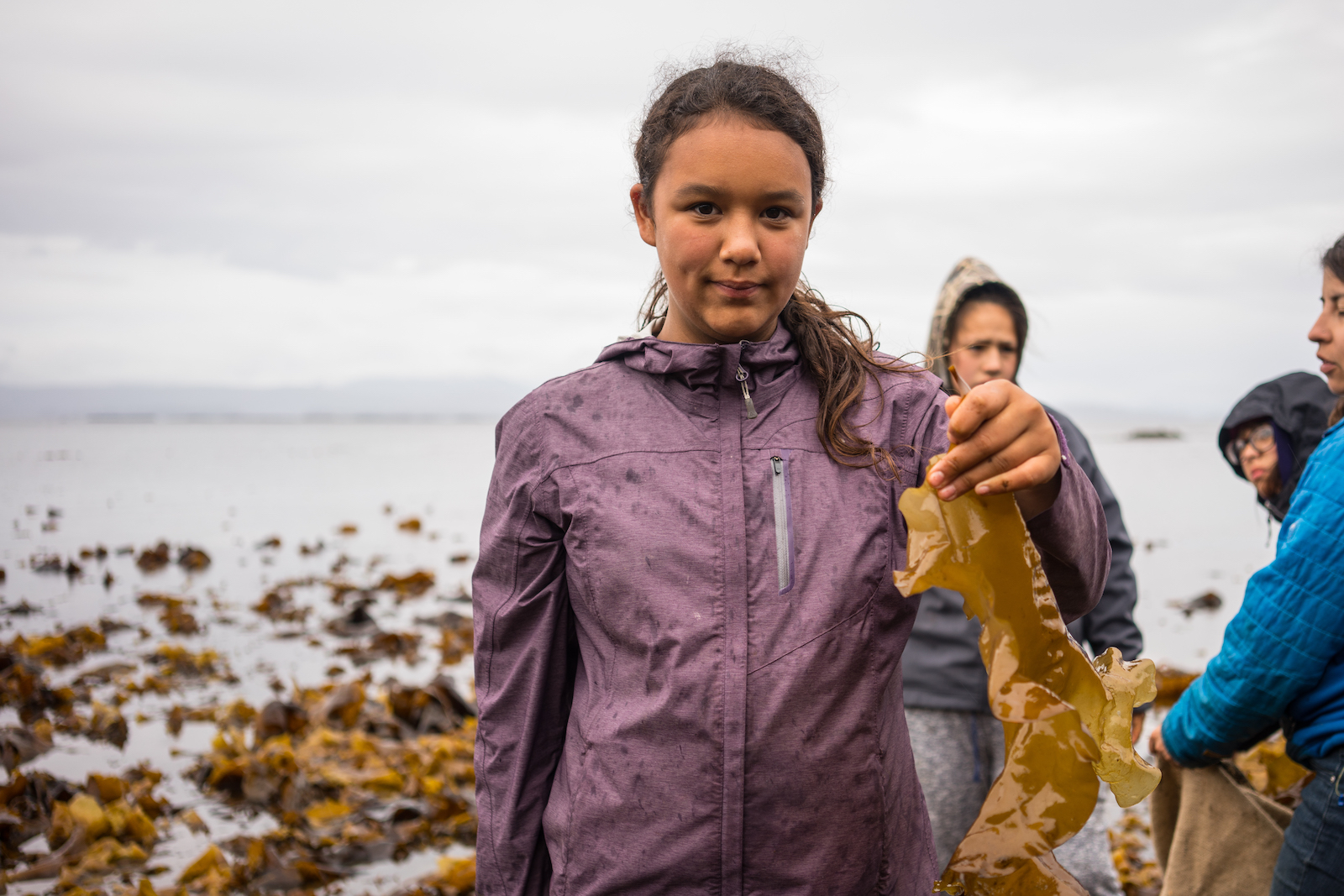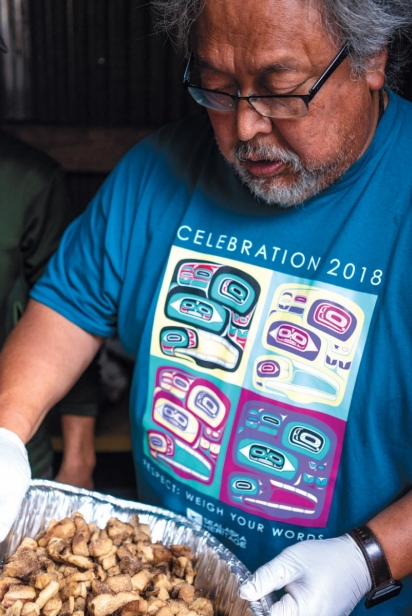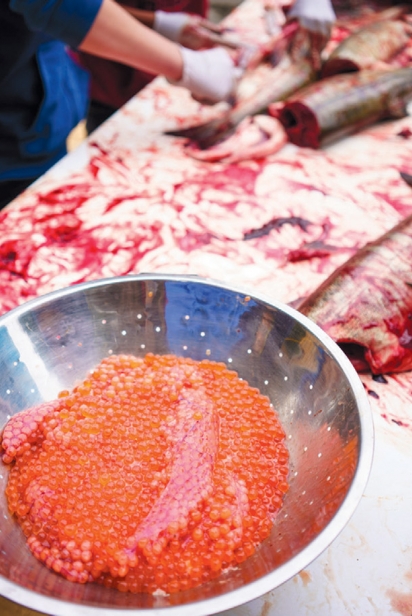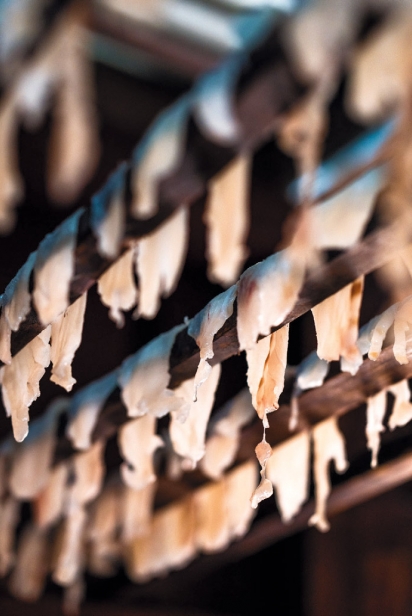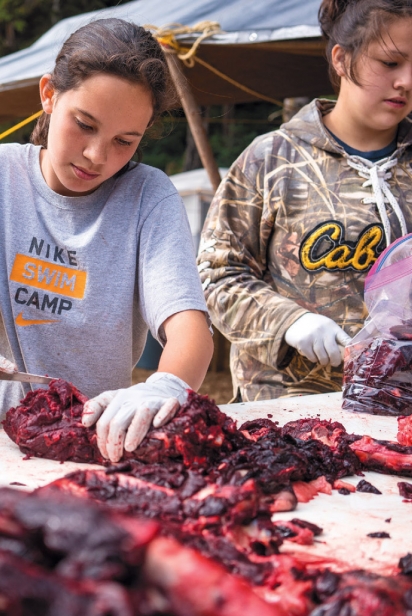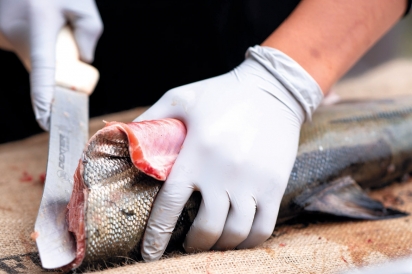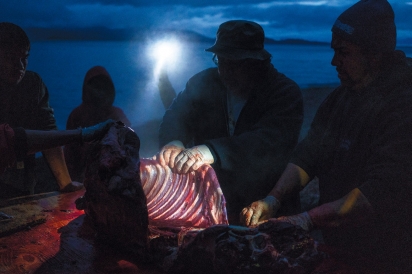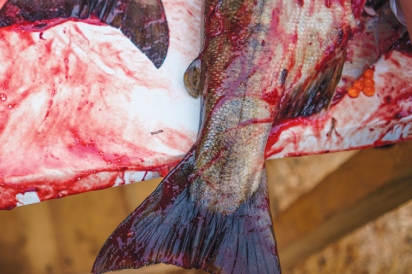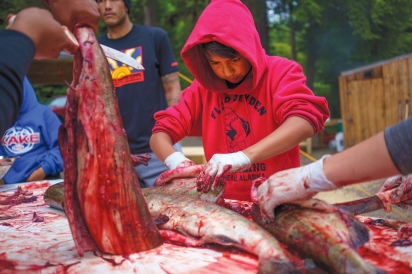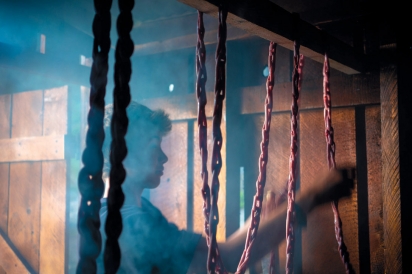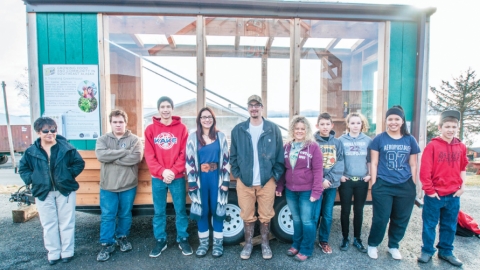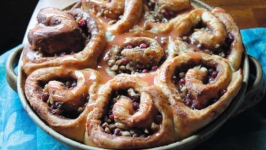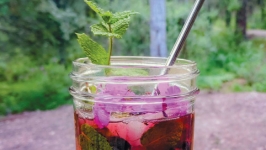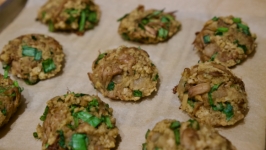Our Way of Life
Keex’ Kwaan Culture Camp
“You aren’t here to meet your boyfriend. You aren’t here to meet your girlfriend.”
A room of fidgeting kids, excited and anxious for the week ahead, roll their eyes while still hanging on Coordinator Mona Evan’s every word.
“You aren’t here to isolate yourself with your cell phones.” Evan gathers all electronics from sticky fingers. “You are here to learn. You are here to participate. You are here to contribute.”
Welcome to Kake Culture Camp.
Tucked between the towering forest and lapping shore, kids help volunteers make camp. They arrange plywood tables, soon to be saturated in the blood and juices of local wild foods. The smokehouse, adorned in the scrawls of past participants, waits empty and eager. Tent poles snap into place, the fire burns, the kids are ready.
Kake Culture Camp is a week-long annual event that strengthens cultural values across generations. Kids learn harvesting and processing skills through a program built by hundreds of volunteers over three decades.
Ask anyone in Kake, this week is special. Though to really understand the significance of camp, to really begin to recognize the magnitude of this seemingly simple event, we need to look back to a darker time, and a different story.
A People in Peril
Mike Jackson’s (Kaa.oosh) memories from the years building up to Kake Culture Camp are visceral. As the magistrate judge in remote Alaska during the ’80s, he also served as the de facto coroner.
During that period, he says, a suicide epidemic struck Kake.
“I had to go investigate all of these suicides before the state troopers came and make sure the scene was locked down. But I also had to make the determination if a person was dead on the scene if there was no doctor,” says Jackson.
In a community of fewer than 700 residents, there are very few strangers.
“It was emotional responding because all the people who committed suicides here I knew.” Jackson, like too many in Kake, lost cousins, lost friends, lost neighbors.
“At that time, there was a study that was done on suicides in our state. Kake had the most, and Alaska led the nation. So where did that put us?” he adds.
To address the root causes of this hurt, not just the symptoms, the community would need to plunge hands deep into the earth and dig. Healing would require the roots of these losses to be surfaced and mended. This was because, although this epidemic seemed to spread needlessly across the community like a virus, with dozens of attempted and actual suicides gripping the community in its fist, it hadn’t cropped up randomly.
Alaska has a heavy history of colonization, marginalization, and the exploitation of local people and resources. Lands were stolen, language and culture suppressed, and generations of Native Alaskan children were taken from their culture, often forcibly removed from their families and villages by the government.
“I was lucky to be in that generation where I wasn’t shipped off to school, so I grew up learning the values of my community on how to be a parent, how to be an uncle, how to be a family and look after one another,” says Jackson, whose older siblings and parents were sent to boarding schools.
“A bunch of those people never came back home. And the ones that did missed out on the whole parenting concept of growing up in a village, and some of them lost the tribal values of gathering and the respect for the land.”
In those days, logging was booming in Kake. The cannery and cold storage were still active, people were fishing and processing. The city had introduced a liquor store in the 1960s to cater to the logging operation, remembers Jackson.
“Over 200 people came in from Washington, Oregon, Idaho to log with a whole different cultural concept of values: of working hard, but also drinking hard,” he says.
People were returning from war, the community was injected with cash and easy access to alcohol, and all of this was intermixed with a growing distance from the cultural values and protocols that had governed the community for thousands of years.
“The kids got into alcohol, and when you have that volatility of alcohol and cash, things go wrong: boat accidents, hunting accidents, car accidents, domestic violence,” says Jackson.
The solutions were also divisive. The judge remembers evangelicals coming to town, as he puts it, “to save the natives.” They tossed aside the Tlingit culture as devil worship and blamed it for Kake’s darkness. They burned regalia.
“That kind of stuff weighs pretty heavy on your mind when you are a little kid being told you are a devil because you participated in dance or culture. Kids were becoming young adults and were losing hope, losing culture, losing values, and they turned to suicide to end their misery,” Jackson recalls.
“We would bring in consultants and they would leave after they came in for a day or two because they are expensive. What did they leave us with besides waiting for the next consultant to come in and solve our problems?” asks Jackson. He confronted the city council and offered an idea.
“I think we are going to have to do this ourselves. We need to step up,” he told the members.
In 1988, with the self-determination of the council and community, Culture Camp was born.
The Comparative Value of Seal Meat
At camp, a skiff barrels through the chop toward shore. Participants, pulled to the water’s edge with the gravity of anticipation, greet visitors with open arms. Camp depends entirely on the donation of wild foods by community members.
“In 30 years, the community has never let us down,” Evan says.
This time the visitors bring a seal—an adored staple for the community of Kake. The mottled animal is heaved onto the pebbly beach. The creamy insulating blubber is carefully sliced in strokes to reveal brilliant layers of crimson and lavender, meat and viscera still vibrant with freshness.
Seal meat is so dense in iron, Tlingit people have used it as a remedy for anemia for thousands of years. According to the camp’s cooks, 4 ounces of seal meat boast the same density of minerals as 48 hot dogs, or 24 hamburgers.
Campers take turns dipping and cleaning the intestines in the sea. They braid and weave them for the smokehouse, training the delicate muscles of their growing fingers to twist and dance in ways familiar to these shores for generations.
Each year, the camp menu is a mystery. It all depends on what the community brings and what the campers harvest. Labrador tea, jams and jellies, crab, gumboots, seaweed, venison, moose, seal, halibut, all the different salmon, devil’s club, and more—the length of this list is a testament to the abundance of local lands and waters.
Re-grounding a ‘Lost Tribe’
Ruth Demmert (Kaanak) is one of Kake’s most treasured culture bearers. She was the original Subsistence Coordinator when camp began in 1988.
Today, Demmert is 82 years old. Speaking slowly, deliberately, and lovingly, she describes those years leading up to the creation of camp as a collective wandering.
“It was the loss of our culture, our language,” she says. “It made us feel lost, like a lost tribe or something.”
For her, Culture Camp became a ground, a place for the wandering to re-learn the values that lock the Tlingit people to place and community.
“First of all, to have respect for yourself, also respect for the land, respect for the animals, respect for the elders, respect for others’ property—these values are important.”
Stories and principles in Tlingit culture are not accidental, Evan further explains. Protocols, procedures, and social norms were developed to maintain balance, to keep peace, to promote sustainability, and to cultivate well-being. These foundations and principles are as dynamic as the communities and people themselves, ever adapting.
“We never had mental health, behavioral health professionals in our midst like we do today,” Evan says. “But our culture seems to handle that by having stories, and these stories gave the youth the ‘why’ and the ‘why not.’” For example, she explains how processing food requires a particular state of mind and how this belief system helped the community to cope.
“You try to process with a happy heart, with no sadness or anger or fear, because that is going to be transferred into what you are working on,” says Evan. “If you are working on something with anger, it’s not going to turn out, it will spoil.” This concept of introspection and pause helps us lay down grief down and step into the present moment. While working hard with family and friends, our hands deep in nature’s gifts, we can focus on joy.
It is clear that joy is present at camp today with laughter and song ricocheting from table to table. When one table becomes boisterous, however, a second Tlingit principle surfaces. One of the campers, who dared to guzzle a mouthful of raw salmon roe, starts choking and spitting brilliant orange orbs. Camp Co-founder Jackson steps in to demand respect for the foods. The kids straighten out and listen.
“Being at camp reminds me of that whole situation where your child is going to be placed under the guidance and discipline of aunties and uncles, or an elder or grandparent,” says Evan. Uncles and aunts assume the responsibility of teaching harvesting practices in Tlingit culture, in part, because youths tend to be more responsive and adults are often too delicate and forgiving with their own children.
Responsibilities, however, are reciprocal. Camp has never been a means to simply discipline youth. Evan reflects on the inception of camp, those early days when she was a camper herself.
“You have your addictions, and you have the children exposed to the parents who are suffering those addictions, and it becomes a cycle. We had the alcohol, we had the drugs and domestic violence, and pulling kids into a place like Culture Camp, where they are taken from that and given consistency and a schedule, even for a short amount of time, helps them work through the head spaces,” says Evan. “But I think even the parents were pushed out of that addiction cycle because they wanted to contribute in a good way to the youth, and not just their youth but the community.”
Evan explains that in Tlingit culture, power is determined not by a capitalist value of how much wealth an individual accumulates. Rather, one’s worth is gauged by how much they give away, how much they contribute.
With backs arched diligently over tables, people across generations work on seaweed and slice through slippery salmon. The busyness stretching over camp seems as endless as the summer sunlight. Drenched in that deep indigo that insulates July, the sky becomes a blue backdrop to the dark silhouettes of tired campers hauling halibut carcasses as big as themselves to shore. The hard-earned end to the day is settling upon the shoreline. People are resting when distant headlights slide down the logging roads and flash between trees.
The body of a black bear, shot for aggressive behavior in town, is swung from truck to table. The tempo shudders and shifts. A little girl on the lap of an elder murmurs sadness for the bear. Although eaten, bear is a less common food. Its skinned body appears uncomfortably familiar, almost humanoid.
The eyes of camp are darting for leadership when Jackson calls for attention.
This meat, this animal and gift will be respected. And so, with dancing curls from the smokehouse twisting through the beams of headlamps, the residual sunlight dissipates, and the campers get back to work.
On Fire and Food
Culture Camp has not been a panacea remedy for Kake’s ailments. However, the values of self-sufficiency, care, and respect have created a bedrock foundation and identity that allow generations of Kake’s youth to come of age with support.
“Was Culture Camp the whole end of all suicides and all of people’s issues? No. But we’ve seen the community calm down,” says Jackson. “It’s just one of the tools we used to create a light in our community from the darkness when people were confused who they were, why they were bad people, why we didn’t fit in in the world, why people hated us and wanted to change us into a different color, why they told us that our god wasn’t worthy or our way of living was the trashy way.”
The scene unfolding on these shores is anything but trashy. Campers, visiting elders, and volunteers are pulled to the warm fire. For Demmert, this glowing circle has always been the epicenter of healing. “When we sat around the campfire, we would talk about the things that bothered you. There were tears, but they were healing tears.” The skills and activities were essential, but the fireside was where the hard and badly needed conversations emerged between generations.
“You can’t just keep your struggles underground. We can talk about it now. Back then, nobody could talk about it. Camp has allowed the community to heal,” adds Demmert.
Soon the tempo of the stories plateaus, and laughter settles into soft resting smiles. The breath and heartbeats of the group sync and slow in reflection.
“Today, we have the third-generation group of children who went through culture camp now running it. We have children, like our grandchildren as a result, going off to school, learning both sides. They are learning the science of what we gathered and fine tuning it,” reflects Jackson.
“It wasn’t just the Culture Camp, but camp was one of the main tools in our community to create a safe place, a proud place for people to grow up. We have doctors that went through camp, we have attorneys, we have professional people in corporations all around the world. We are also looking at kids, that have their heads screwed on right, knowing who they are, where they grew up, and the value of the resources around them, that still choose to come home and help the community become a better village. To me, that’s everything, people going off to get their degrees, coming back home to help our community. To us, this is our world, this is our heaven,” says Jackson.
Steaming devil’s club tea, with all its healing properties, slides down our throats. Skewered hooligan is passed, and one camper offers the seal flipper he’s been cooking, crackling over the flames, to loosen the fur and scorch the fat. Bellies fill, and hearts are happy.
When we read about food between the pages of a magazine full of glorious recipes and families sitting around tables, we admire only a tiny fraction of its power. The beauty and difficulty of Kake’s Culture Camp story is a reminder of the profound, rich complexity that can manifest in every bite we choose to cultivate, harvest, honor, and share in Alaska. Food connects us to each other, to our values, to our ancestors, and our future. This complexity is one that only a seasoned culture bearer can properly settle in two sentences.
“We don’t call this subsistence,” says Demmert. “We call it our way of life.”


